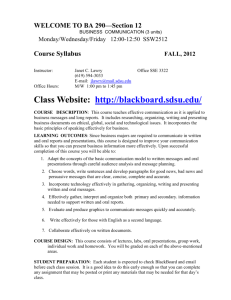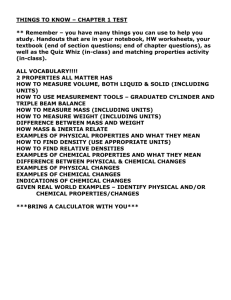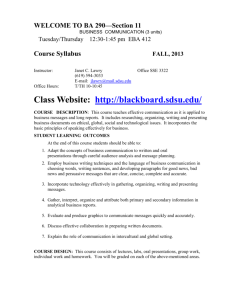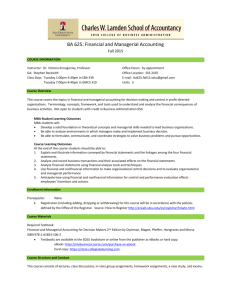course information - San Diego State University
advertisement
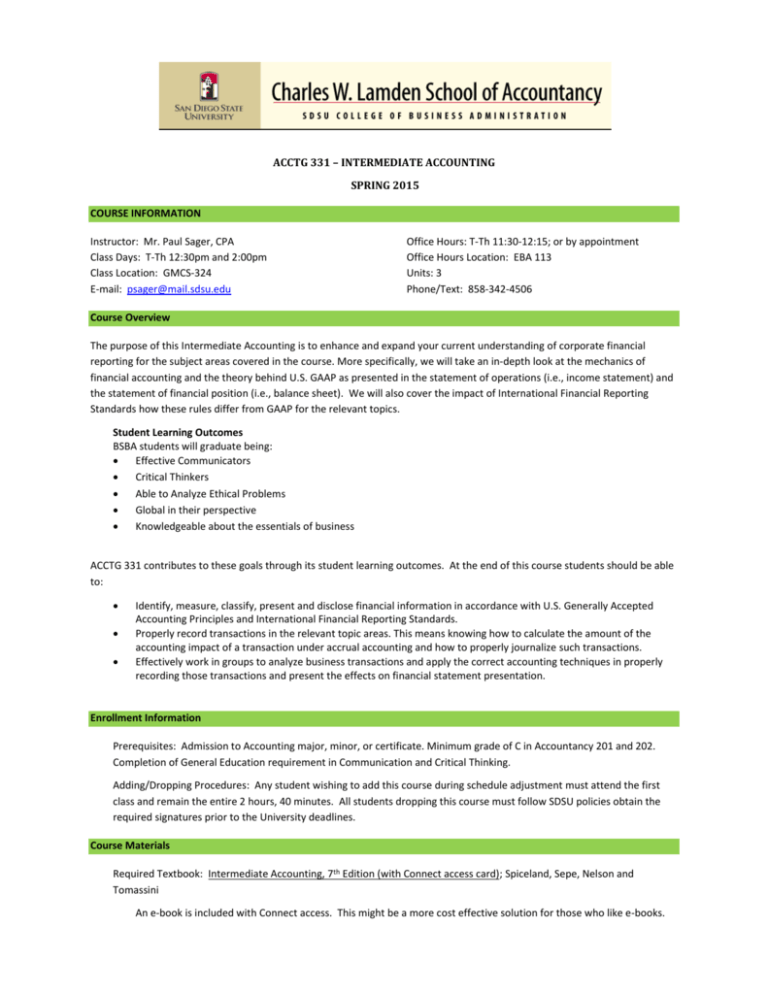
ACCTG 331 – INTERMEDIATE ACCOUNTING SPRING 2015 COURSE INFORMATION Instructor: Mr. Paul Sager, CPA Class Days: T-Th 12:30pm and 2:00pm Class Location: GMCS-324 E-mail: psager@mail.sdsu.edu Office Hours: T-Th 11:30-12:15; or by appointment Office Hours Location: EBA 113 Units: 3 Phone/Text: 858-342-4506 Course Overview The purpose of this Intermediate Accounting is to enhance and expand your current understanding of corporate financial reporting for the subject areas covered in the course. More specifically, we will take an in-depth look at the mechanics of financial accounting and the theory behind U.S. GAAP as presented in the statement of operations (i.e., income statement) and the statement of financial position (i.e., balance sheet). We will also cover the impact of International Financial Reporting Standards how these rules differ from GAAP for the relevant topics. Student Learning Outcomes BSBA students will graduate being: Effective Communicators Critical Thinkers Able to Analyze Ethical Problems Global in their perspective Knowledgeable about the essentials of business ACCTG 331 contributes to these goals through its student learning outcomes. At the end of this course students should be able to: Identify, measure, classify, present and disclose financial information in accordance with U.S. Generally Accepted Accounting Principles and International Financial Reporting Standards. Properly record transactions in the relevant topic areas. This means knowing how to calculate the amount of the accounting impact of a transaction under accrual accounting and how to properly journalize such transactions. Effectively work in groups to analyze business transactions and apply the correct accounting techniques in properly recording those transactions and present the effects on financial statement presentation. Enrollment Information Prerequisites: Admission to Accounting major, minor, or certificate. Minimum grade of C in Accountancy 201 and 202. Completion of General Education requirement in Communication and Critical Thinking. Adding/Dropping Procedures: Any student wishing to add this course during schedule adjustment must attend the first class and remain the entire 2 hours, 40 minutes. All students dropping this course must follow SDSU policies obtain the required signatures prior to the University deadlines. Course Materials Required Textbook: Intermediate Accounting, 7th Edition (with Connect access card); Spiceland, Sepe, Nelson and Tomassini An e-book is included with Connect access. This might be a more cost effective solution for those who like e-books. Recommended Textbook: Financial Accounting Exam Questions & Explanations 18th edition – Gleim Scantrons: We will be using the red Parscore forms (F-289) for all exams. Calculator: A financial calculator is required for use in this course. Financial calculators have the time value of money function keys (e.g., PV, FV, PMT, N, I/YR). Examples include (but are not limited to): TEXAS INSTRUMENTS MODEL – BA II PLUS HEWLETT PACKARD MODEL – 10B HEWLETT PACKARD MODEL – 12C Excel: Some assignments will require using Excel. Students can use SDSU resources or provide their own computers. Blackboard: This course will be managed via the Blackboard course website. Therefore, each student needs an email account. Please make sure that you update your email address in the SDSU database. You can check on your Blackboard email account (or update/change it) by going to the SDSU Web Portal at http://sunspot.sdsu.edu/portal. The Blackboard website will be where I make announcements, upload class slides and solutions for assignments. All points for assignments and exams that factor into the students’ grades will be posted on Blackboard. Course Structure and Conduct CLASS LECTURES: Classes will consist of lectures using PowerPoint slides and in-class problems/exercises that are designed to help students better understand the correct financial reporting rules for a variety of common business transactions. Students are responsible for downloading and printing the slides from the Blackboard website. The pace of my lectures and in-class exercises are based on the assumption that students have read the textbook material ahead of time and printed out the relevant slides for class (i.e., YOU ARE PREPARED FOR CLASS). BLACKBOARD: This course will be managed via the Blackboard course website. Therefore, each student needs an email account. Please make sure that you update your email address in the SDSU database. You can check on your Blackboard email account (or update/change it) by going to the SDSU Web Portal at http://sunspot.sdsu.edu/portal. The Blackboard website will be where I make announcements, upload class slides and solutions for assignments. All points for assignments and exams that factor into the students’ grades will be posted on Blackboard. CONNECT ONLINE HOMEWORK: The graded homework assignments must be completed and submitted online by 2:00pm on the due date. The homework system will not accept any homework submissions made after the assigned date and time. Students will be allowed three attempts for each homework problem. The homework is designed to be a supplementary tool to help students: 1) understand the concepts covered in the financial module and 2) apply the concepts in a practical situation. All homework assignments will be completed online via Connect that comes with your edition of the Spiceland textbook. All students must register online in accordance with the instructions found in your Connect access card that you purchased with your Spiceland textbook. You will need to provide a user name and password to log on and do the homework assignments throughout the semester. Multiple students cannot use the same access card. The following website is where you need to go to access the homework problems. Please register at the following websites (depending on your section) by clicking on the “Register as Student” link and following the instructions: http://connect.mheducation.com/class/p-sager-spring-2015-sager Each graded homework assignment is worth a maximum of 10 points and points are earned on a sliding scale based on the accuracy of your answers. The lowest homework score will be dropped. The grading scale will be as follows: % of Homework Answered Correctly Homework Points Earned <60% 0 points 60.0% to 79.99% 5 points >=80% 10 points Students with Disabilities If you are a student with a disability and believe you will need accommodations for this class, it is your responsibility to contact Student Disability Services at (619) 594-6473. To avoid any delay in the receipt of your accommodations, you should contact Student Disability Services as soon as possible. Please note that accommodations are not retroactive, and that accommodations based upon disability cannot be provided until you have presented your instructor with an accommodation letter from Student Disability Services. Your cooperation is appreciated. Academic Honesty The University adheres to a strict policy regarding cheating and plagiarism. These activities will not be tolerated in this class. Become familiar with the policy (http://www.sa.sdsu.edu/srr/conduct1.html). Any cheating or plagiarism will result in [Insert your policy on cheating or plagiarism, e.g. failing this class and a disciplinary review by Student Affairs.] Examples of Plagiarism include but are not limited to: Using sources verbatim or paraphrasing without giving proper attribution (this can include phrases, sentences, paragraphs and/or pages of work) Copying and pasting work from an online or offline source directly and calling it your own Using information you find from an online or offline source without giving the author credit Replacing words or phrases from another source and inserting your own words or phrases Submitting a piece of work you did for one class to another class If you have questions on what is plagiarism, please consult the policy and this helpful guide from the Library Turnitin Students agree that by taking this course all required papers may be subject to submission for textual similarity review to Turnitin.com for the detection of plagiarism. All submitted papers will be included as source documents in the Turnitin.com reference database solely for the purpose of detecting plagiarism of such papers. You may submit your papers in such a way that no identifying information about you is included. Another option is that you may request, in writing, that your papers not be submitted to Turnitin.com. However, if you choose this option you will be required to provide documentation to substantiate that the papers are your original work and do not include any plagiarized material. Assessments and Grading Course grades will be assigned in accordance with San Diego State University policy (see General Catalog, pp. 468-470). Undergraduate grades shall be: A (outstanding achievement, available only for the highest accomplishment), B (praiseworthy performance, definitely above average), C (average, awarded for satisfactory performance, the most common undergraduate grade), D (minimally passing, less than the typical undergraduate achievement), F (failing). Table1. Your course grade will be based on the following weighted components Component POINTS (PERCENT) Unit Test Ch 1, 2 100 10% Unit Test Ch 3, 4, partial 21 100 10% Unit Test Ch 5, 7, partial 6 100 10% Unit Test Ch 8, 9 100 10% Unit Test Ch 10, 11 100 10% Unit Test Ch 12,13, partial 6 100 10% Less one Unit Exam dropped (100) (10%) Final Exam-Cumulative 200 20% In-class assignments (20 points each) 100 10% Homework (10 points each, lowest dropped) 100 10% Group Simulation (15 points each) 60 6% Accounting Assessment 10 1% Attend Accounting Orientation 10 1% CALCPA registration 10 1% Attend 2 Career Services Sessions 10 1% 1,000 100% TOTAL UNIT TESTS: There will be six unit test exams. Students will need a Parscore sheet (F-289) for the exams. Exams will be administered during class times on the dates listed in the class schedule. The lowest Unit Test score will be dropped. Unit tests are not handed back during class period for review by students. If a student wishes to go over their unit test, that student must make an appointment to review the exam in my office. FINAL EXAM-COMPREHENSIVE: he final exam is a comprehensive exam covering all materials in the course. It will have questions on the most important core material covered during the Intermediate Accounting course. IN-CLASS ASSIGNMENTS: In-class assignments will be short problems similar to the homework assigned in connect. Your will show all work and the assignment will be graded for the correct answers as well as your documented methods and calculations. In-class assignments can be individual or group. GROUP WORK: At the beginning of the semester, students will be assigned to groups via Blackboard. When you log into your Blackboard account, your group number will show up on the bottom of your home screen. This group will be your permanent group for the entire semester for all graded group assignments. GRADED GROUP WORK: There will be four graded simulation assignments during the semester. These simulations are designed for students to work in their groups outside of class. Points will be earned on a group basis based on the accuracy of the groups’ answers to the simulations. All members of the group will receive the same point score unless one or more team members do not contribute equally to the assignment. Each submission will include a contribution percent for each team member. If a team member’s contribution is less than others, the student’s score will be reduced proportionally. For example, if the simulation score is 12 and student A contributes at 50% of the other team members, student A will receive 6 points and other team members will receive 12 points. In addition, one or more of the graded in-class assignments will require you to work with your group. All group members present will receive the same score. IN-CLASS, UNGRADED WORK: The in-class group work will consist of open-book/notes ungraded exercises designed to have students analyze different business transactions and practice application of relevant concepts and principles in financial reporting. In-class group work does not have to be done in your assigned groups. 10-K ANALYSIS-UNGRADED: Each group will select a public company at the beginning of the semester. Throughout the semester groups will be asked to present and discuss how their selected company has reported and disclosed the relevant accounting topics. This is not graded, but will help students learn how the topics are implemented in practice. JOIN CALCPA REQUIREMENT : The CalCPA is a professional organization dedicated to increasing the value and promoting the integrity of the CPA profession, contributing to the success of their members and strengthening client, employer, public and government trust in CalCPA member advice, work products and opinions. As new accounting majors, you likely have a multitude of questions about the profession and what it means to be an accountant in the state of California. The CalCPA’s website (http://www.calcpa.org/content/home.aspx) is a useful resource in learning more about the accounting profession. The website also provides information that can be very useful to someone wanting to learn more about the accounting profession such as CPA exam information, CPA license requirements in the state of CA and other career resource information. In addition to the information resource benefits, CalCPA has multiple scholarship opportunities available to its student members. As a requirement for this course, every ACCTG 331 student is required to join the CalCPA as a student member. Membership is free. You must join by February 28, 2015. Please email me proof of your membership (e.g. a snapshot of your account information under the “My Account” link or a scanned printout of your account page or you can just copy the account page onto a Word document or copy it directly into the body of the email and send it to me). ATTEND CAREER SERVICES WORKSHOPS REQUIREMENT: Seeing how getting a job seems to be a common goal for many (if not all) accounting students at SDSU, it is extremely important to get connected to the Career Services Department. Career Services’ main goal is to help students develop the tools necessary to obtain employment during school (internships) and after graduation (full-time employment). Therefore, we are requiring every ACCTG 331 student to attend two Career Services workshops by the end of the Spring 2015 semester. Here is the web link to the Career Services website: http://career.sdsu.edu Grade of Incomplete. A grade of Incomplete (I) indicates that a portion of required coursework has not been completed and evaluated in the prescribed time period due to unforeseen, but fully justified, reasons and that there is still a possibility of earning credit. It is your responsibility to bring pertinent information to the instructor and to reach agreement on the means by which the remaining course requirements will be satisfied. The conditions for removal of the Incomplete shall be reduced to writing by the instructor and given to you with a copy placed on file with the department chair until the Incomplete is removed or the time limit for removal has passed. A final grade is assigned when the work agreed upon has been completed and evaluated. An Incomplete shall not be assigned when the only way you could make up the work would be to attend a major portion of the class when it is next offered. Contract forms for Incomplete grades are available at the Office of the Registrar website Tentative Course Schedule Table 2. The course schedule, including topics and class activities listed by week, is presented in the following table Changes to the course schedule, if any, will be announced in class. DATE Feb 10 Tu TOPIC COVERED Syllabus Principles of Accounting Assessment --Bring PARSCORE Financial Accounting Framework Review of Accounting Process In-class exercise-ungraded Balance Sheet-Start ACCOUNTING ORIENTATION—MANDATORY ATTENDANCE UNIT TEST # 1 LAST DAY TO DROP Balance Sheet Income Statement Income Statement Feb 12 Th Statement of Cash Flows Jan 22 Th Jan 27 Tu Jan 29 Th Jan 30 1pm Feb 3 Tu Feb 5 Th Feb 17 Tu Feb 19 Th Feb 24 Tu Feb 26 Th Mar 3 Tu Mar 5 Th Mar 10 Tu Mar 12 Th Mar 17 Tu Mar 19 Th Mar 24 Tu Mar 26 Th In-Class Exercise #1 Simulation # 1 DUE UNIT TEST # 2 Income Measurement and Profitability Analysis Income Measurement and Profitability Analysiscomplete Cash and Receivables Time Value of Money (Recorded Lecture) Cash and receivables-complete In-class exercise #2 Simulation # 2 DUE UNIT TEST # 3 Inventory Chap 8 Inventory Chap 8-complete In-class Exercise - Ungraded Inventory Chap 9 Inventory Chap 9-complete In-Class Exercise #3 UNIT TEST # 4 RELEVANT CHAPTERS CH 1 CH 2 CH 2 CH 3 CONNECT ASSIGNMENT HW #1: Ch 1&2 DUE CH 1, 2 CH 3 CH 4 CH 4 CH 4 CH 21 Part A & C CH 4, 21 HW #2: Ch 3 DUE HW #3: I/S DUE HW #4: SCF DUE CH 3, 4+21A/C CH 5 CH 5 HW #5: Chap 5 DUE CH 7 CH 6, Part A HW #6: Chap 6A&7 DUE CH 5,7 CH 8 CH 8 CH 9 CH 9 CH 8,9 HW #7: Chap 8 DUE HW #8: Chap 9 DUE RELEVANT CHAPTERS DATE Mar 31 Tu SPRING BREAK Apr 2 Th SPRING BREAK Apr 7 Tu PP&E and Intangible Assets CH 10/11 Apr 9 Th PP&E and Intangible Assets CH 10/11 Apr 14 Tu PP&E and Intangible Assets-complete In-class exercise #4 Simulation # 3 DUE Apr 16 Th UNIT TEST # 5 CH 10,11 Current Liabilities Time value of money, pp 321-342 (recorded lecture) Long-term Liabilities Long-term Liabilities completed In-class exercise #5 Simulation #4 DUE UNIT TEST # 6 Review CH 13 CH 6 pp. 321-342 CH 14 Apr 21 Tu Apr 23 Th Apr 28 Tu Apr 30 Th May 5 Tu May 7 Th May 9 Sat 3:30pm TOPIC COVERED CH 14 CH 13, 14, 6 Review FINAL EXAM- Comprehensive ALL MATERIAL CONNECT ASSIGNMENT HW #9: Chap 10&11 DUE HW #10: Chap 13 DUE HW # 11: Chap 6&14 DUE

